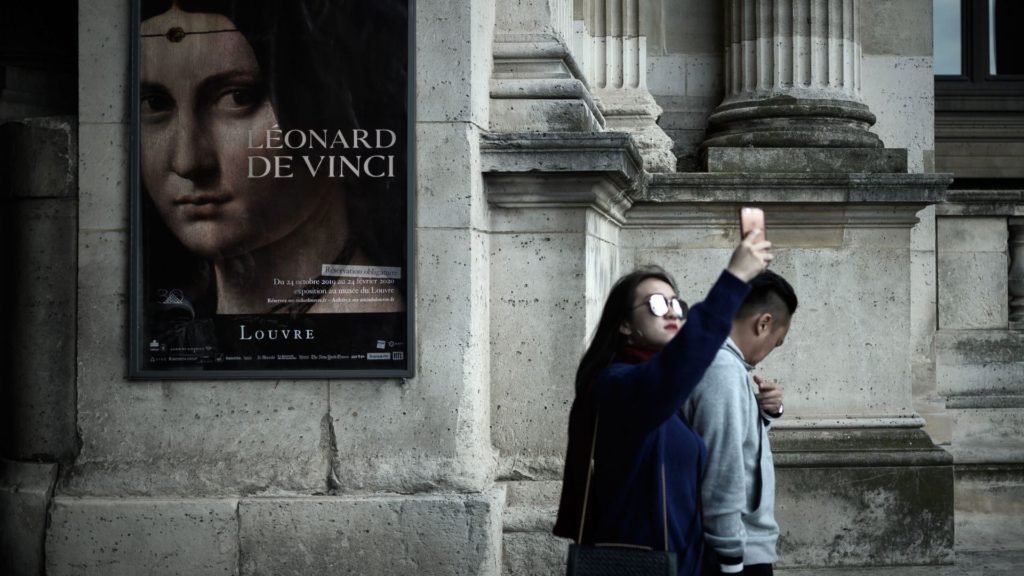One thing you have to say about Leonardo da Vinci is that he really packs them in. The last major Leonardo exhibition, at London’s National Gallery in 2011–12 (“Leonardo da Vinci: Painter at the Court of Milan”), counted 323,897 visitors, a record for Leonardo. This year, the five-hundredth anniversary of the artist’s death, that record will be easily broken. At least half a million people in the United Kingdom have seen a selection of two hundred Leonardo drawings, owned by the Royal Collection Trust, that were dispersed among twelve museums in the country during the first half of this year before being brought together in The Queen’s Gallery in May.1 (A selection, fifty of the two hundred drawings, is on display at the Queen’s Gallery, Palace of Holyroodhouse, Edinburgh, from November 22, 2019–March 15, 2020.)
The Louvre’s exhibition “Léonard de Vinci” has proved to be a blockbuster as well. On the opening day in October, it was announced that over 220,000 tickets had already been sold, and total sales are predicted to exceed half a million before the show closes in February.2 A decade in the making, it is the most comprehensive exhibition of the artist’s work ever mounted, including two-thirds of his surviving paintings and well over a hundred drawings. The only Renaissance artist who can defeat Leonardo in the competition for eyeballs is Michelangelo, whose Sistine Chapel in the Vatican receives an average of twenty thousand visitors per day, year round. The Met’s exhibition last year of Michelangelo drawings (see my review in The New Criterion of December 2017) registered over seven hundred thousand viewers. No other Renaissance artist even comes close to the crowd-pulling capacity of Leonardo and Michelangelo. Not even Raphael, once considered a co-equal member of the Holy Trinity of High Renaissance artists. The greatly praised exhibition of his drawings at the Ashmolean in Oxford two summers ago was considered a huge success when it brought in just sixty-five thousand visitors.
On straightforwardly artistic grounds, it’s not obvious that his paintings offer great pleasure to the casual art lover. Five hundred years of toiling to find genius in them tends to obscure this fact.
It is worth reflecting on the reasons why Leonardo has such appeal for the modern museum-going public. On straightforwardly artistic grounds, it’s not obvious that his paintings offer great pleasure to the casual art lover. Five hundred years of toiling to find genius in them tends to obscure this fact. Elements of their composition can seem strained, jumbled, or incongruous, as in the case of Virgin and Child with St Anne (1503–1519), which has lovely and original rhythms but is awkward in the posing of its subjects. Raphael’s greatest compositions, lively, fluent, graceful, and harmonious, are vastly superior to any produced by Leonardo. The latter’s execution sometimes appears erratic, inexplicably careless. Leonardo certainly mastered the principles of vanishing-point perspective, discovered in Florence in the 1420s, as drawings for his Adoration of the Magi (1480–81) show. Yet his Annunciation, completed only a few years before (ca. 1472) in his mid-twenties, is strangely faulty in the application of those principles. Leonardo made careful studies of the proportions of the human body, most famously in his drawing Vitruvian Man (ca. 1487), on view in the Louvre show. But in the mature Portrait of Cecilia Gallerani (1489–90), the subject’s hand, caressing her pet ermine, is too large for the rest of her body, as though a drawing of that detail had been transferred to the portrait without resizing. Given his unsuccessful experiments with oils and the passage of time, it is hard to know the original effect of his colors, but on the evidence of the pictures as they have survived Leonardo was not a delicious colorist.
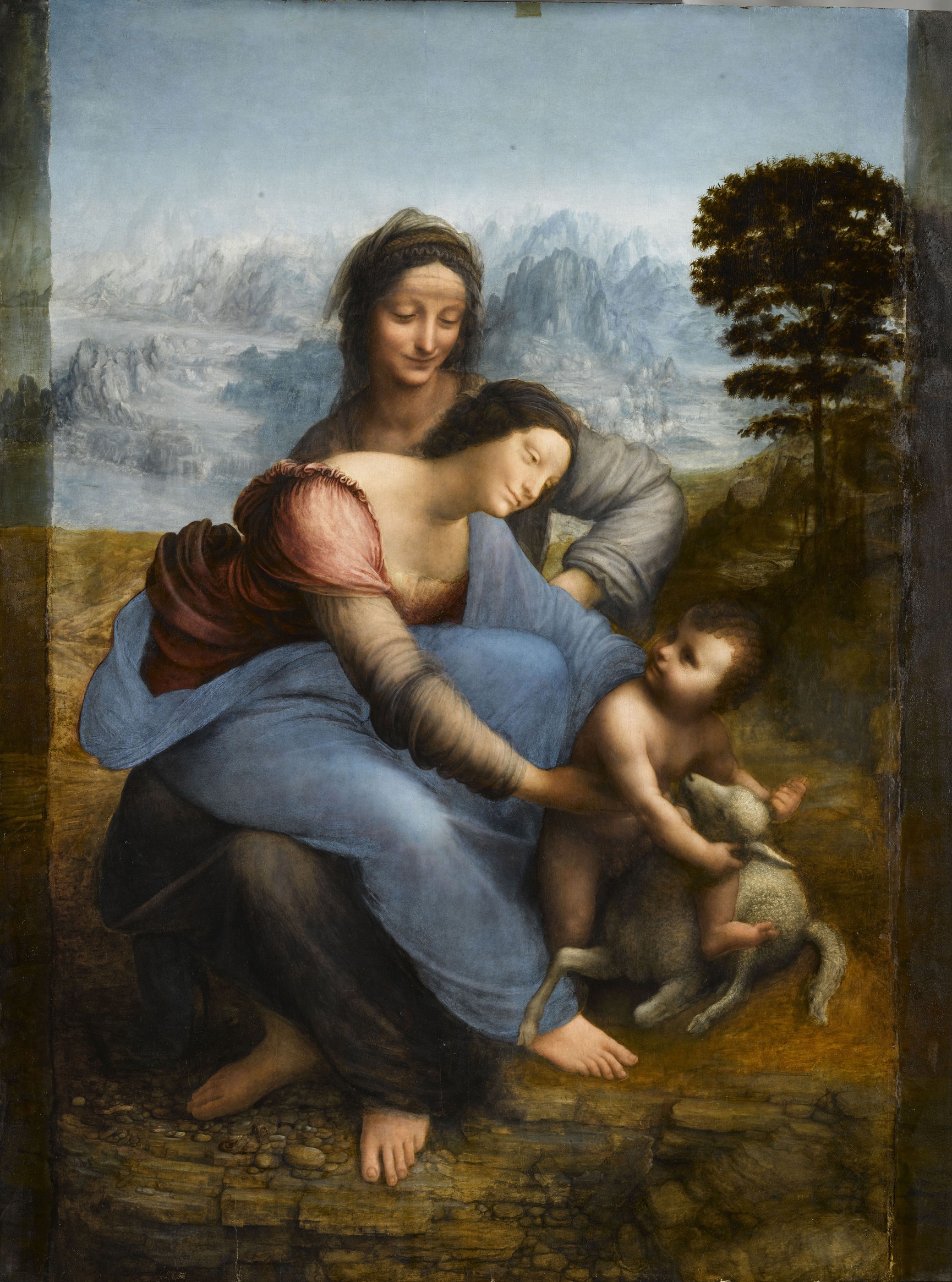
Museum-goers in search of his artistic genius will also be frustrated by the difficulty of determining exactly what Leonardo himself contributed to the artifacts on display. This is a subject on which the experts continue to disagree, sometimes drastically. Very few of the fifteen or sixteen surviving paintings can be confidently attributed to Leonardo in their entirety. The majority of the works he began were left unfinished. One extraordinary virtue of the Louvre exhibition is to provide life-sized or enlarged reflectographic images of all the paintings, which reveal as never before the stratified character of their production. Sometimes Leonardo has provided only the underdrawing, leaving the painting to be finished by other hands. In one case, the Portrait of a Musician (ca. 1485), the reflectographic image shows a far more refined and psychologically eloquent image beneath the cruder one now visible on the wooden support. A number of his unfinished paintings have been completed by less-skilled hands. Sometimes the master has only retouched paintings worked up by disciples and other artists, possibly from his designs, possibly not. Some of his paintings Leonardo worked on over many years, introducing from time to time alterations, reworkings, and additions, leading to various unsatisfactory outcomes. Deciding which elements in a given artifact come from the hand of the master can provide an engaging set of puzzles for the amateur art-lover, but the pleasure is more intellectual than aesthetic.
Nevertheless, the crowds are coming to see something, and it would be presumptuous to believe they are mere puppets of the art world’s propaganda. One is tempted to think just that when one sees the thousands of tourists waiting to see the Mona Lisa for thirty seconds from twenty feet away (she was thankfully not included in the Louvre’s show, which was mounted below grade in a different gallery). But let us put aside unworthy thoughts. Leonardo unquestionably offers museum-goers access to something the Renaissance invented and the modern world still prizes: artistic and scientific genius. And he offers access to his genius in a way that puts few barriers between himself and the modern viewer.
One obstacle the modern observer need not negotiate is religion. Though more than half of his paintings are of religious subjects, Leonardo is not a religious painter. Our best source for his biography, the Lives of the Artists by Giorgio Vasari, tells us
in his old age Leonardo lay sick for several months, and feeling that he was near to death he earnestly resolved to learn about the doctrines of the Catholic faith and of the good and holy Christian religion. Then, lamenting bitterly, he confessed and repented, and, although he could not stand up, supported by his friends and servants he received the Blessed Sacrament from his bed. [Translated by George Bull]
What is astonishing in this anecdote is the supposition that Leonardo, despite his insatiably curious mind, had never bothered throughout his life to learn the basic teachings of Christianity. One would have thought that, for professional reasons alone, an acquaintance with Christianity’s biblical and doctrinal sources would have been worth his time. More revealing is a line that Vasari suppressed from the definitive edition of his Lives, where he adds, after a passage describing Leonardo’s fascination with the workings of nature,
through [this study] he created in his mind a conception so heretical that he would not come near to any kind of religion, considering it perhaps a better thing to be a philosopher than a Christian.
Vasari is suggesting that Leonardo embraced one of the philosophical religions of the Renaissance, the predecessors of modern anti-religious humanism. That is presumably why Leonardo’s art contains no spiritual messages to embarrass modern faithlessness. He is not trying to induce religious emotions in the beholder or visualize biblical stories in aid of spiritual edification like Giotto, Donatello, or his teacher Verrocchio. His sacred families are above all human families, human beings alive with refined, delicate emotions. The viewer never feels that they illustrate a sermon whose message he can’t accept.
What is astonishing in this anecdote is the supposition that Leonardo, despite his insatiably curious mind, had never bothered throughout his life to learn the basic teachings of Christianity.
Leonardo, in other words, resembles the modern type of humanist, free (or bereft) of religion, seeking orientation in the world by human reason and human observation alone. He was never a humanist such as the Renaissance produced from the time of Petrarch, over a hundred years before his birth. This circumstance removes another barrier between the artist and his modern viewers. To be a Renaissance humanist meant learning classical languages, mastering classical texts, and above all accepting the ancients—including ancient Christians—as models for modern lives. An artist influenced by Renaissance humanism (or a humanistically educated artist like Vasari) produced learned art, requiring a classical education to appreciate. Humanist art was also didactic, meant to communicate moral and political lessons. All of that was foreign to Leonardo. He had almost no formal education and could not read Latin, the doorway to all the academic disciplines in his time. As a youth he was given basic training in Florentine business methods (which he despised and flouted) and was apprenticed to the trade of making decorative objects for the wealthy in the workshop of his master Verrocchio. He is an Old Master, but he does not participate deeply in the rich Christian and classical traditions that inform the art of the Old Masters from the Renaissance down to the eighteenth century. Hence little or no knowledge of history, classical literature, or even Christian sources is required to appreciate Leonardo’s works. Your head can be perfectly empty of religion and traditional culture and still marvel at Leonardo’s recreations of nature. For most modern museum-goers, that provides immense relief from what might be called the anxiety of ignorance.
What lies at the center of Leonardo’s modern appeal are the emotions of wonder and astonishment. This too is readily understandable, since, for us moderns, genius—sheer intellect—has replaced heroism, virtue, philosophical wisdom, and sanctity as the highest perfection of human nature. Despite Leonardo’s limitations as a producer of beautiful artifacts, what is blindingly obvious to every viewer of his work is that Leonardo was a genius.
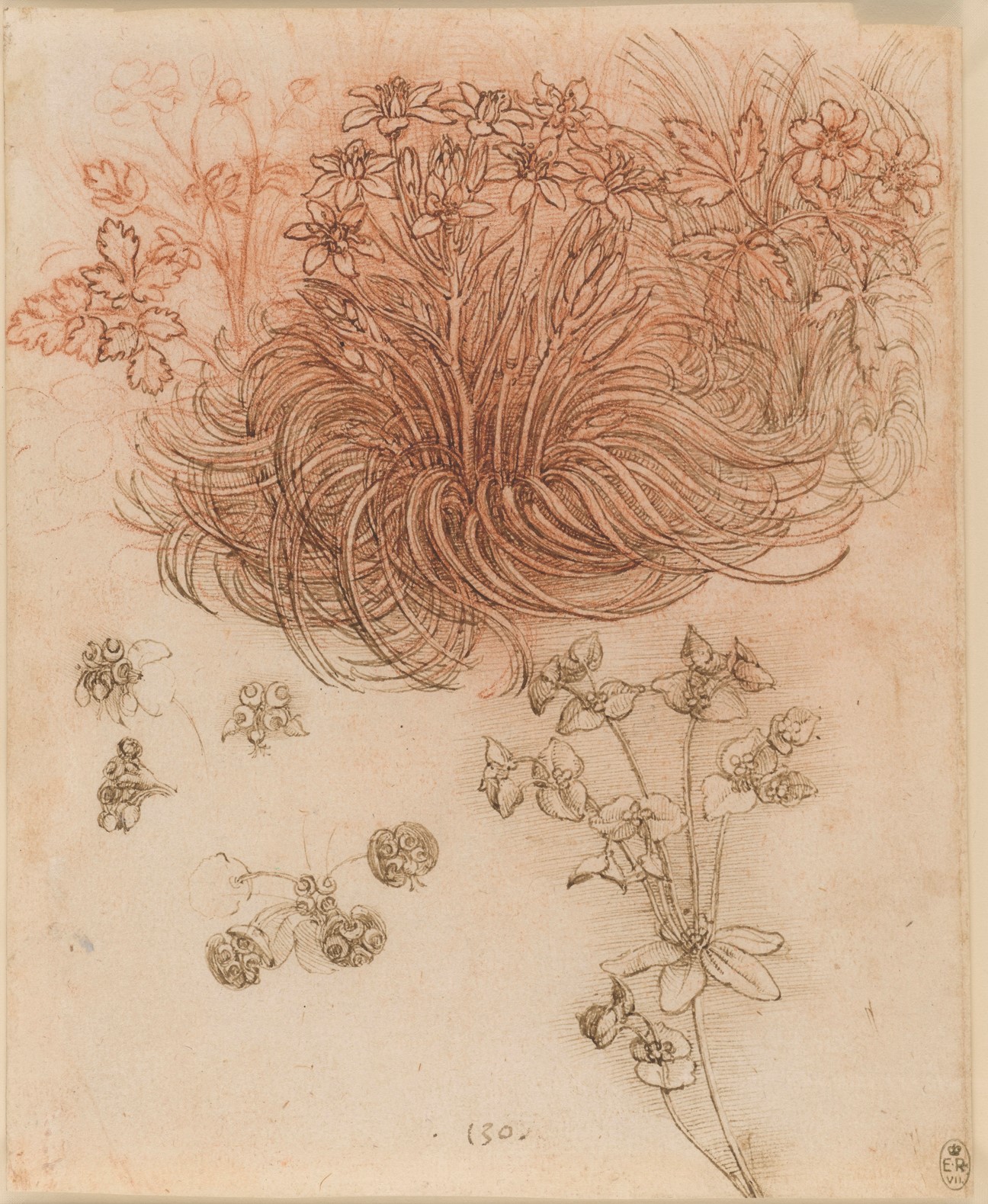
His genius is revealed along two axes that meet in the finest parts of his paintings. One axis is his scientific study of nature, disclosed in his famous notebooks. Twenty of these survive—twelve of them in Paris’s Institut de France, three in London’s Victoria and Albert Museum—comprising some four thousand sheets. In addition there are many hundreds of single-sheet drawings. Almost six hundred of these were collected by Charles II in the seventeenth century and now belong to the Royal Trust. That is how the show in Buckingham Palace could provide an ideal introduction to the full range of Leonardo’s scientific interests. Leonardo was a supremely visual thinker, so the student of his drawing can follow directly his process of thought as he analyzes the workings of human and animal bodies, the structure of plants, the visual effects of landscapes on the eye, and the science of light and shadow. Leonardo absorbed from his Florentine context and above all from Leon Battista Alberti the Platonic-Pythagorean doctrine that nature was mathematical in structure, and that therefore geometry and proportion were guides to beauty and accuracy of representation. Mathematics remained an obsession throughout Leonardo’s life, and his close friendship with Luca Pacioli gave him access to the leading expert of the day on the sciences of geometry and proportion.
Leonardo was a supremely visual thinker, so the student of his drawing can follow directly his process of thought as he analyzes the workings of human and animal bodies, the structure of plants, the visual effects of landscapes on the eye, and the science of light and shadow.
The contemporary viewer tends to be most dazzled by Leonardo’s designs for machines, for there too his scientific imagination aligns with modern attitudes, especially his thirst for power over nature. Leonardo was not a contemplative student of nature in the Aristotelian tradition, aiming at understanding for its own sake. Nor was his science subordinated, as it was for the medieval scholastics, to natural theology—to comprehending the design of God in nature and in us. A great deal of Leonardo’s science was oriented instead toward solving practical problems of technology, especially military technology. Artists in the Renaissance were expected to act also as civil and military engineers, and this was exactly the skill that Leonardo sold to his first great patron, the Duke of Milan, in a famous self-promoting letter of 1482. He lived most of his life in the courts of princes and needed to demonstrate the value of his genius to them. It was this necessity that led him to his wilder flights of imagination, the airplanes, helicopters, submarines, armored cars, siege engines, and schemes to drain moats and redirect rivers. All of his engineering projects turned out to be unworkable, but that does not detract from their brilliant prescience of modern technological achievements.
The one real achievement of Leonardo’s science was the training of his mind and hand to represent certain aspects of nature with a verisimilitude that cannot but produce wonder. Even after study of Leonardo’s notebooks, it remains hard to fathom his ability to reproduce the sensations made on our eyes by drapery, fabrics, skin, lips, eyes, faces, and hands. No other artist comes close to Leonardo in this ability to make a painted portrait look present and alive and filled with thought. Leonardo’s conception of painting as a science, a manual form of photography as it were, was best expressed in 1551 by the polymath Girolamo Cardano, the son of one of his closest Milanese friends, Fazio Cardano:
Painting is the finest of the mechanical arts, and the noblest. It creates more wondrous things than poetry or sculpture. The painter deploys shading and color and marries them with the gift of precise observation. He must be a master of everything, for everything interests him. The painter is a philosopher of natural science, an architect and a skillful dissector. In this is rooted the excellence of his portrayal of every part of the human body. This skill was some time ago developed and brought to near perfection by Leonardo da Vinci. (De subtilitate 17)
Yet Cardano, one of the greatest medical authorities of his time, later denied the scientific value of Leonardo’s anatomical drawings, writing of them that “they were very beautiful and most worthy of such a famous artist, but indeed useless; he did not even know the number of intestines. He was a pure painter, not a doctor or a [natural] philosopher.”
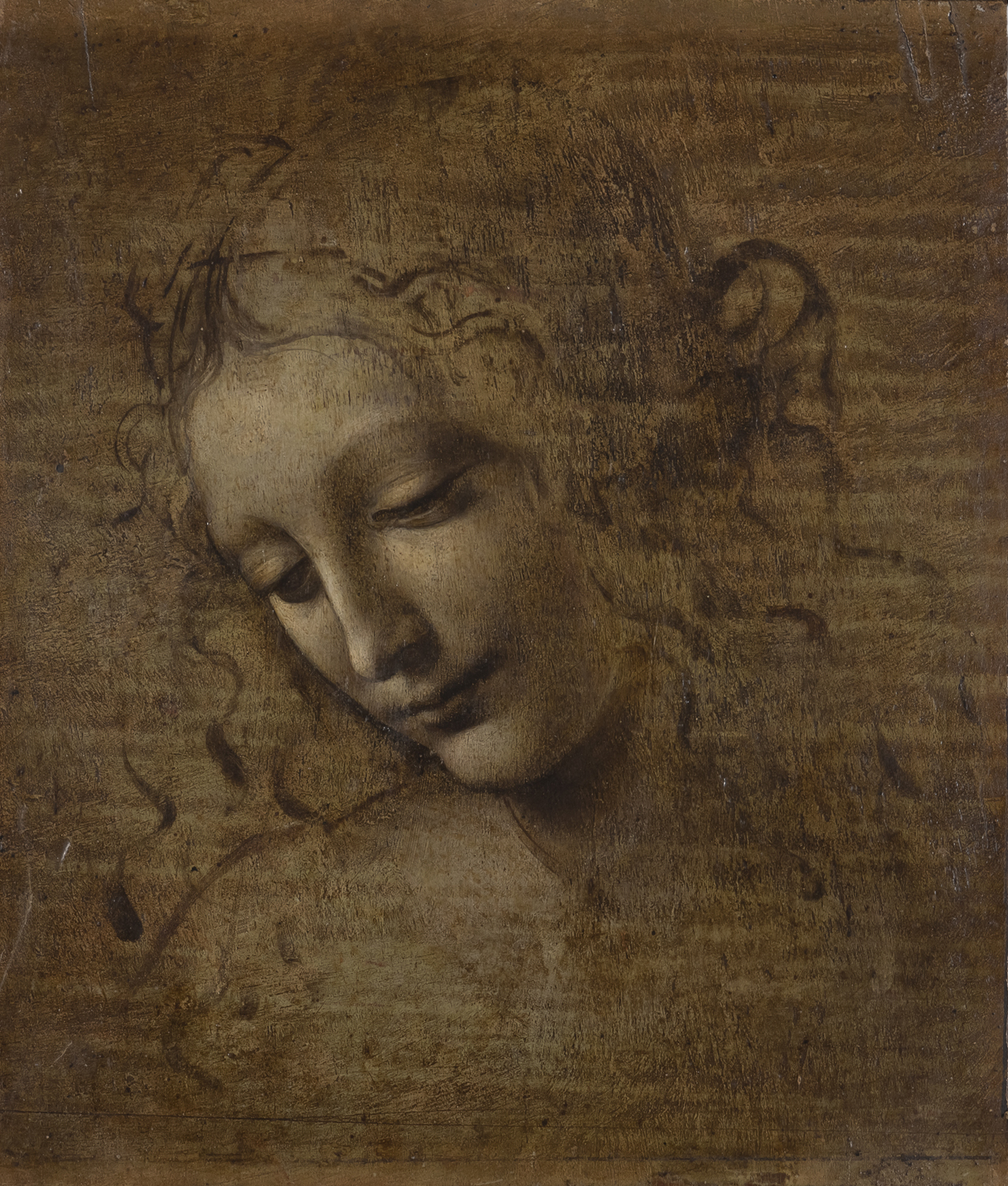
Vasari, in his biography of Leonardo, writes as though his genius for representing nature was effortless, a divine gift, but we know from other sources, and above all from the objects themselves, that Leonardo’s way of painting required superhuman patience and attention to detail. It also required a huge investment of time and thought. Leonardo was no Tintoretto or Rubens, covering acres of canvas, helped by teams of assistants. His was an intensely personal process, and each object (and most of his paintings are relatively small objects) could take years, or a lifetime, to complete. Or not complete.
Leonardo’s astonishingly lifelike images thus came at considerable cost, a cost paid mostly by his patrons. Princes and potentates all over Europe lusted to possess works by Leonardo, but the word got out long before he left Milan in 1499 that contracts and advance payments were no guarantee that the great master would actually finish the work he had agreed to make. As the old reference-letter joke runs, you were lucky to get him to work for you. Despite his admiration, Vasari could not quite conceal his distaste for Leonardo’s unorthodox work habits and his lofty disregard for contracts. The artist was famous for his mistreatment of patrons who failed to appreciate his searching and open-ended creative process or who insisted in too mercantile a fashion on getting value for money.
Vasari tells the famous story of Leonardo’s quarrel with the prior of Santa Maria delle Grazie, a monastery in the city of Milan where the artist was painting his Last Supper on the the wall of the refectory. His slow progress after two years of fitful work was compromising the feeding habits of the monks, and the prior’s impatience was beginning to boil over. “If the prior had had his way,” writes Vasari, “Leonardo would have toiled like one of the laborers in his garden and never put his brush down.” The prior complained to the duke, but the artist was able to explain to his sympathetic patron that “men of genius sometimes accomplish most when they work the least.” Slyly he mentioned that the two faces in the Supper that posed the greatest difficulties for him were the face of Christ and that of Judas his betrayer. He had despaired of conceptualizing the beauty and divine grace of the Incarnate Deity, but should he not succeed in finding a model for the face of so ungrateful and treacherous an individual as Judas, he could always copy the face of the prior. At that the duke roared with laughter and the prior retired discomfited from the field of courtly combat.
Yet Leonardo continued to find patrons and pupils to the end of his days, famously dying in the arms of his greatest admirer, King Francis I of France.
The story gives us some clues about how Leonardo got away with his lifetime habit of taking on projects he could not finish and perhaps had no intention of finishing. A man who painted with the tip of his brush clearly had no business accepting commissions to cover hundreds of square feet with paint, yet Leonardo took on two such projeccts, The Last Supper and the Battle of Anghiari, the latter a large battle scene to be painted on one wall of the huge Sala del Cinquecento in Florence’s Palazzo Vecchio. Normally such vast areas would be painted using the technique of fresco, which required an artist to apply paint quickly to large tranches, or giornate, of up to fifty square feet in a single day, so that the paint could be fixed in wet plaster before it dried. Leonardo did not paint in fresco, a method obviously unsuited to his work habits. He tried to get around the problem by experimenting with a new kind of oil paint mixed with a varnish stabilizer. He hoped his invention would stick to plaster walls and thus allow him to apply paint at his leisure. The experiment failed, however, and the Last Supper had begun to deteriorate within twenty years of its completion. By the time Vasari saw it in 1556, there was “nothing visible but a muddle of blots.” (What is visible today in Milan is largely the work of generations of restorers.) The same fate would surely have awaited the Battle of Anghiari if Leonardo had not hightailed it back to Milan less than a year after beginning to colorire the battle scene, leaving it unfinished. He took with him the unfinished Mona Lisa and the Virgin and Child with St. Anne, both promised to Florentine patrons. The men who had paid Leonardo to work on them never saw those paintings again.
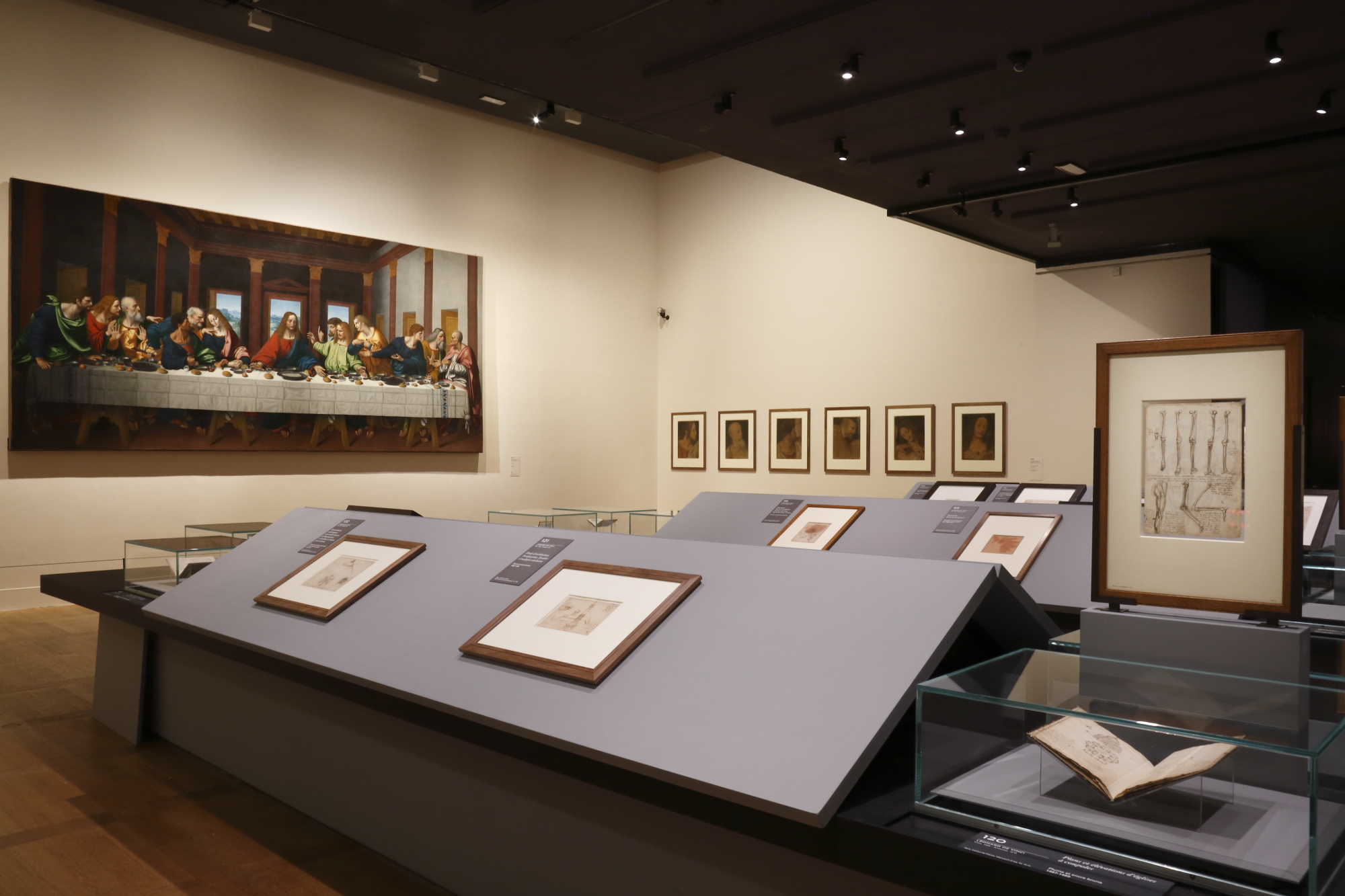
Yet Leonardo continued to find patrons and pupils to the end of his days, famously dying in the arms of his greatest admirer, King Francis I of France. He continued to be regarded with veneration by his fellow artists and by connoisseurs of painting. Contemporaries were obviously willing to put up with a great deal from an individual of such colossal talent, but there were other circumstances working in Leonardo’s favor as well. He had been a beautiful boy and grew into a strikingly handsome man with a magnificent presence. He was a brilliant improvisatore of songs to the lute. He was a sparkling conversationalist, a persuasive pitch-man, generous to a fault, and he had a rare capacity to make himself loved by others. He was, in other words, an ideal courtier.
In the end, Leonardo’s art was less about the objects he created than about himself creating the objects. Vasari tells us that when he finished the cartoon for the Virgin and Child with St. Anne in 1501, “for two days it attracted to the room where it was exhibited a crowd of men and women, young and old, who flocked there as if they were attending a great festival, to gaze in amazement at the marvels he had created.” His powers of creation provoked then, as they do now, wonder and astonishment. He claimed to belong to an aristocracy of talent in an age that was challenging inherited privilege on every front. To be his patron or his friend was to be admitted to the presence of genius at work, to observe at close hand the virtù of a great prince of science and art. Thanks to the devoted curators Martin Clayton at the Royal Collection and Vincent Delieuvin and Louis Frank at the Louvre, whose exhibition catalogues are worthy counterparts to the shows, and to the generosity of their patrons, we too can share that privilege.
1 “Leonardo da Vinci: A Life in Drawing” was on view at The Queen’s Gallery, Buckingham Palace, from May 24 through October 13, 2019.
2 “Léonard de Vinci” opened at the Louvre, Paris, on October 24, 2019, and remains on view through February 24, 2020.
